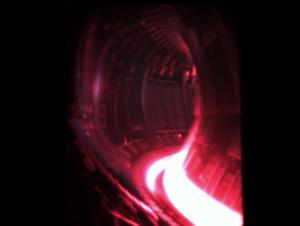More results from JET's record-breaking 2021 campaign
In 2021, researchers from the European consortium EUROfusion introduced the high-performance fuel mix of deuterium and tritium into the JET tokamak for only the second time in its history. The "DTE2" campaign that followed produced a highly publicized world record for the most energy produced in a single fusion shot, and terabytes of data to be analyzed and modelled for the benefit of ITER and future fusion reactors. A more complete set of results has now been published in a special issue of Nuclear Fusion and will be presented in talks throughout the week at the 29th IAEA Fusion Energy Conference.
The 40-year-old JET tokamak is unique in its ability to operate with the heavy hydrogen isotopes deuterium and tritium (DT), which fuse at temperatures that scientists and engineers can reach in a fusion installation (between 100 million and 200 million degrees Celsius). JET's DTE2 campaign, with a series of high-fusion-yield DT experiments, was designed to test crucial physics and technology aspects of reactor-relevant DT fusion plasmas ahead of ITER operation.
In a press release published today, the EUROfusion consortium unveiled the main scientific results from the 2021 DTE2 campaign.
"One of our most eye-catching results is the first direct observation of the fusion fuel keeping itself hot through alpha heating. This is the process where high-energy helium ions (alpha particles) coming out of the fusion reaction transfer their heat to the surrounding fuel mix to keep the fusion process going," said Costanza Maggi, a UKAEA Fellow and former JET Task Force Leader. "Studying this process under realistic conditions is crucial to developing fusion power plants."
Self-heating plasmas are the key to producing electricity from fusion energy, allowing for sustained, ongoing fusion reactions despite strongly reduced input power from external heating sources. These important JET results on alpha heating are featured in a just-published special edition of Nuclear Fusion (click here) and also in Physical Review Letters.
Other important results from the DTE2 campaign include the confirmation of predictions from advanced computer models for heat transport inside the plasma, successful tests of tritium recovery methods, the verification of a heating technique planned for ITER, and the successful demonstration of a control technique to protect the walls of the divertor.
The JET team just brought a third and final campaign of experiments—DTE3, focusing on plasma science, materials science and neutronics—to a close last week. EUROfusion will be communicating about DTE3 results before the end of the year.


